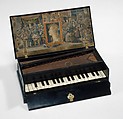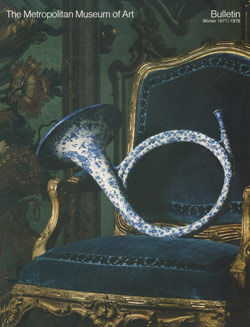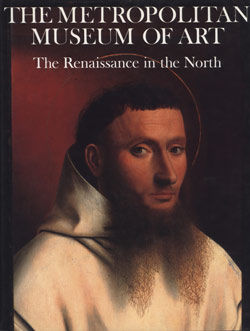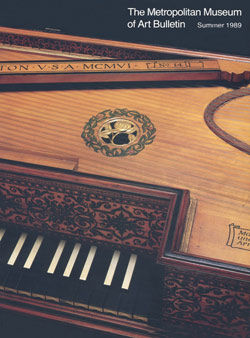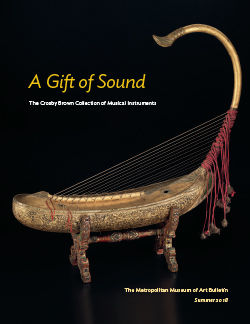Rectangular Octave Virginal
The small virginal was for a lady’s parlor, serving both as sewing box and as instrument for casual music making and to accompany singing. The ebony, casketlike case is in the style of Samuel Biedermann the Elder, probably made in Augsburg about 1600, and is decorated with engravings by Hans Sebald Beham and the elder Crispijn van de Passe. A delicate parchment rosette adorns the sound hole. Two shallow drawers, perhaps for sewing equipment, fit into the top of the lid. Sounding an octave above normal pitch, this virginal was not intended for serious music-making, but the three octave keyboard compass of f–f”’ (omitting f-sharp and g-sharp in the low octave) approximately covers the range of women’s and children’s voices.
Such instruments, fashionable in the first half of the seventeenth century, were a specialty of Augsburg cabinet and instrument makers. The instrument, having neither maker’s name nor the Augsburg hallmark, was probably built by a pieceworker for a distributor. The hallmark would have not been granted in any case, as the instrument is not made of solid ebony. Rather, the maker used soft blind wood and veneered it with ebony, and in some areas he resorted to black varnish to imitate ebony.
Technical description: Case of ebony and dark-stained wood with two small drawers in the lid, the inside of the lid is decorated with colored paper prints, probably not original; compass f.g.a. --f3, bone naturals with fronts of key levers stained black, black stained accidentals with ebony plates, keyboard front rail, balance rail, and back rail are glued to the bottom, key dip controlled by padding on front rail, keys guided by wooden slips in rack; jacks are of pear with beech tongues, brass leaf springs (some are quill replacements), quill plectra, single flag dampers, and small lead weights, jacks are guided by punched leather strips glued to the soundboard and separate lower guide, two jacks share on slot, but a small crosspiece has been glued below the soundboard in each slot to separate the jacks; the soundboard has a small pierced parchment rose. (Douglas Maple 1983)
Due to rights restrictions, this image cannot be enlarged, viewed at full screen, or downloaded.
